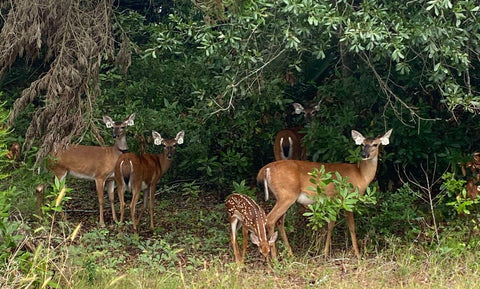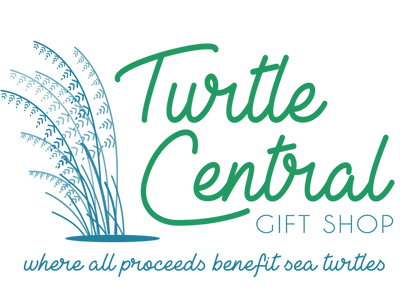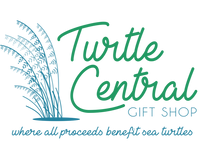Critters of Bald Head Island
If you come across injured or distressed wildlife on BHI,
please keep a respectful distance and call the Wildlife Emergency Hotline: 910-457-0089 ext. 5.
Squareback Marsh Crab

- Best Habitat: Mangrove forests and salt marshes along the East Coast.
- Why BHI: Our brackish water in our marshes are the perfect home for these critters. The Kent Mitchell trail is a great spot to find these crabs during low tide.
- What can we do: The Squareback Marsh Crab depends on water for oxygen exchange through their gills. If you spot one, it is best to leave it in its habitat. These guys do not make for a good in-home pet.
- Harmful: Not to humans. They can become territorial with their neighbors, though.
- Fun Fact: Squarebacks are skilled climbers. When they feel threatened, they have been known to climb palmetto, pine, or oak trees to hide.
- How does it help BHI: The Squareback Marsh Crab is a species that is a good indicator to marsh health. The more Squarebacks your see, the healthier the marsh habitat!
Odonates (Dragonflies or Damsel Flies)

- Best Habitat: Freshwater habitats--the healthier the water, the better!
- Why BHI: Bald Head Island is home to multiple freshwater lagoons, ponds, and other bodies of water.
- What can we do: Help keep our freshwater habitats clean by picking up debris while walking/biking/golf carting around the island. If you see any trash in the water, please pick it out (when it is safe to do so--look out for alligators!).
- Harmful: No. Odonates may be carnivores, but they do not bite humans. They're beautiful little creatures that are fun to watch as they zoom around.
- Fun Fact: They have two sets of wings that allow them to hover and even turn in mid-air similar to a helicopter. Some species can even fly up to 20 miles per hour!
- How does it help BHI: Odonates are carnivores and enjoy feasting on mosquitos and gnats--the best natural "repellent" you can have! Odonates are also indicator species of healthy freshwater systems. The more you see them around a water source, the healthier it is!
Eastern Glass Lizard

- Best Habitat: Most commonly found in flatwoods and around wetlands in sandy habitats.
- Why BHI: With its mixture of sandy dunes, maritime forest, and the marsh, BHI is the perfect home for these lizards.
- What can we do: These little guys are not snakes nor are they venomous. Keep an eye out for a "snakelike" lizard that can actually move its moveable eyelids and external ear openings.
- Harmful: Not at all. They are very docile and can be found under boards and other debris.
- Fun Fact: These legless lizards earned their moniker "glass" due to the ability to break or "shatter" their tail in multiple locations. The common belief that these pieces can rejoin is a myth, although the tail will regrow over several months or years.
- How does it help BHI: Glass lizards enjoy a wide variety of insects, spiders, and other invertebrates as well as small reptiles and possibly small rodents. They're a good lizard to keep around--they help protect us from infectious insects and other pests.
Golden Silk Orb-Weaver

- Best Habitat: Open woods or edges of dense forest. Their webs are usually attached to trees and low shrubs.
- Why BHI: The sub-tropical island provides 173 acres of maritime forest, making it the perfect environment for these orb-weavers to spin their webs.
- What can we do: Being conscious while exploring the island, even in your backyard, so you do not run into its webbing. It can become quite large and sticky.
- Harmful: No--it only bites if held or pinched. Its bite will create only localized pain and slight redness--a bit more painful than a bug bite but not as bad as a bee sting.
- Fun Fact: North Carolina is the farthest north the Golden Silk Orb-Weaver has been documented.
- How does it help BHI: Its prey consists of a wide variety of bugs including mosquitos, flies, bees, wasps, and small moths--helping to reduce the the pesky bug population.
Corn Snakes

- Best Habitat: Corn snakes are commonly found around the edges of old fields and other clearings, where they often hide under the bark of dead pine trees or under logs, old boards, and tin
- Why BHI: Due to the large amount of undisturbed maritime forest on BHI, there are plenty of food resources and available habitat for corn snake populations to thrive.
- What can we do: Unfortunately, corn snakes are often mistaken for copperheads and killed. We can help this critter by educating the public about their identifiable characteristics, that they are nonvenomous, and to interfere with wild animals as little as possible.
- Harmful: They are not harmful/venomous and are commonly kept as pets. They are generally docile when captured, though they will sometimes bite.
- Fun Fact: Corn snakes get their name because they often inhabit barns where mice and rats feed on corn and grain.
- How does it help BHI: Corn snakes are very strong constrictors that eat primarily mice and other rodents. They may eat birds and, when young, may often feed on lizards and treefrogs. They are helpful in keeping the population of other smaller animals in check.
Atlantic Sharp nose Sharks

Photo by Jack King
- Best Habitat: The coastal waters of North Carolina lie along a major migration corridor for marine species, and most shark species occurring along the U.S. East Coast will enter the state’s waters at some point during the year.
- Why BHI: Most sharks found in North Carolina’s sounds and estuaries are transient, making a quick trip into the estuary to feed or migrate through. However, some will use the sounds as a nursery habitat and their young may stay for months.
- What can we do: We can help this critter by educating the public about the importance of sharks, proper shark catch and release techniques, and by interfering with wild animals as little as possible.
- Harmful: Though attacks are extremely rare, many of the species on the ocean side of the barrier islands are large and potentially dangerous to humans, so exercise caution when interacting with these species.
- Fun Fact: This shark is able to tolerate low salinity levels, but they do not venture into freshwater like bullsharks.
- How does it help BHI: Because sharks directly or indirectly affect all levels of the food web, they help to maintain structure in healthy ocean ecosystems.
White-tail deer

- Best Habitat: Maritime forest, sometimes hang out in the dunes
- Why BHI: White-tailed deer thrive in habitats like the maritime forest because of the abundance of food sources and the camouflage the dense vegetation provides for them.
- What can we do: Do not feed wildlife and be careful driving at night when they could be crossing the road
- Harmful: White-tailed deer are not harmful critters
- Fun Fact: When a whitetail deer is alarmed or spooked, it will flash its white tail to alert the others of potential danger.
- How does it help BHI: When a healthy population of white-tailed deer is present, their eating habits can encourage new plant growth within the forest and promote a diverse community of wildlife within the forest ecosystem.
Eastern Box Turtle

- Best Habitat: Maritime forest
- Why BHI: Eastern box turtles thrive in wooded habitats where they can burrow under logs and vegetation
- What can we do: Keep a careful eye out while driving for any critters crossing the road! If there is a box turtle in the road, move it to the side of the road it was heading towards.
- Harmful: Box turtles are not harmful critters
- Fun Fact: The eastern box turtle is North Carolina’s state reptile! As their name indicates, Eastern box turtles can pull their legs and head inside their shell & close up like a box to protect themselves from predators.
- How does it help BHI: Box turtles are omnivores (eat plants & animals) and can help disperse the seeds of many plants. Box turtle eggs can also provide food for other animals like raccoons & red foxes.
Alligator

- Best Habitat: Freshwater lagoons, specifically on the golf course
- Why BHI: There are lots of different ponds available that have good food and shelter
- What can we do: Do not feed wild alligators and keep your distance from them as they are predators
- Harmful: Alligators are not harmful, they are pretty harmless when they are left alone. Please do not harass alligators
- Fun Fact: Female alligators can lay anywhere from 20 to 50 eggs!
- How does it help BHI: Alligators can stir up the water thus moving sediment around, which can provide more habitats and shelter for other aquatic critters.
Birds
- Best Habitat: Forest, marsh, beach, so many different types of habitats have birds!
- Why BHI: Quiet and lots of resources whether it's food or shelter.
- What can we do: Do not feed wild birds unless it's seed from a bird feeder.
- Harmful: Not unless you get too close to its beak
- Fun Fact: Some species can migrate thousands of miles every year.
- How does it help BHI: They are everywhere and provide everyone with the opportunity to observe and see wildlife on BHI.
Sea Turtles
- Best Habitat: The beaches of the southeastern United States & the ocean.
- Why BHI: Sea turtles love BHI because the island provides the multiple habitats and resources it needs to thrive.
- What can we do: Being conscious and responsible about the seafood you eat by asking where and how it was caught. Choose seafood caught in ways that do not harm sea turtles.
- Harmful: No, but keep those hands clear as loggerhead sea turtles can bite with a force of 500 lbs!
- Fun Fact: Sometimes, BHI's loggerhead sea turtles have a magical blue glow on their back called bioluminescence.
- How does it help BHI: The contents (eggs and hatchlings that don't survive) of a sea turtle nest provides vital nutrients for coastal vegetation.





